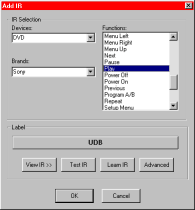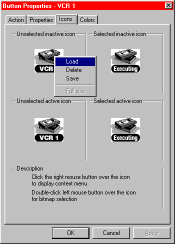|
...Continued from Page 12.
The "View IR" button may not seem like much of an option, but it's a lot handier than it may seem at first. By analyzing the Pronto's infrared hex format, users have come up with utilities that can generate Pronto files containing every single command for a particular device code. Due to this, advanced device functions such as discrete power, transport and input commands have been discovered. It's possible to simply cut-and-paste the hex code off of a web page into this window and gain that functionality, without transferring CCF layout files.

Assigning a preprogrammed code. |
If the remote is hooked up to the computer, you can press "Learn IR" to capture a code directly through the Pronto. Although this option has proved somewhat unreliable for some systems and infrared code formats, it can be very handy to custom designers. One item sorely missing is the ability to specify how long commands should transmit - for instance, some devices require a button to be held for three seconds before it changes inputs. With the Pronto as it is now, it's nearly impossible to incorporate such a requirement into an automated macro, although it could be quickly implemented by the Pronto design team.
Labels & Bitmaps.
Assigning custom labels under ProntoEdit is very similar to using the actual remote - the same characters and symbols apply. What differs is that you can now change font sizes. Although the default configuration uses 14 point type exclusively, ProntoEdit also offers 10 and 18 point options. Through a little finagling, 8, 12 and 16 point options can be added, though only base alphanumeric characters are available (no icons). Several limitations that have yet to be overcome are the lack of multiple text lines on a single button, plus the inability to position text anywhere but "dead center".

Loading in a new bitmap. |
Each button can have four bitmaps assigned: "Pressed" and "Normal" versions for both "Active" and "Inactive" states. "Inactive" bitmaps are only of use when designing templates for users to program on the base remote - otherwise they are of absolutely no concern to the average ProntoEdit user. Those two states should either contain the same buttons as assigned under "Active", or be left blank. ProntoEdit can load in any industry-standard .BMP file, from 1 by 1 pixels up to 240x219 pixels. Though ProntoEdit will resample 256-color or less files down to 4 grayshades, it doesn't really do a good job of it. Files should be saved in 4 grayshades by a professional bitmap editing package, preferably with some form of dithering for best appearances on the physical LCD. Absolutely any bitmap you can imagine can be loaded. My custom configuration, conveniently borrowed from my TS-1000, features a total redesign of the default user interface. Fancy transport controls, device buttons that look like the device, television network logos for use on favorite channel macros… they're all possible.
The new version of ProntoEdit has dropped the "Load", "Save" and "Delete" buttons from under each bitmap box. With the new version you must right-click over the bitmap or empty square to view a pop-up menu with those same options. It sounds awkward, until you realize that double-clicking on an existing image will automatically bring up the "Save" box, while clicking on an empty square shows the "Load" box. Though I would still like on-screen buttons for these functions - no matter how small - the new system does work. Finally, the "Color" tab provides options for the same four states as "Icons" for text labels and button backgrounds (if no bitmap is assigned to a button, it will instead be drawn as a solid color rectangle). WYSIWYG previews are shown at the bottom of the screen.
| 
